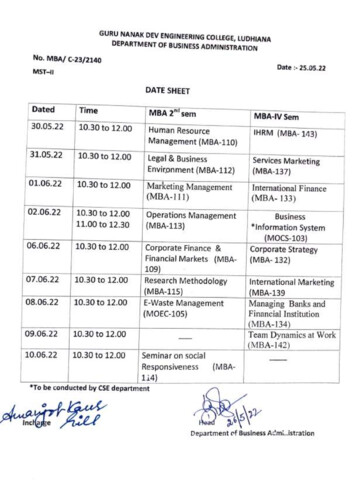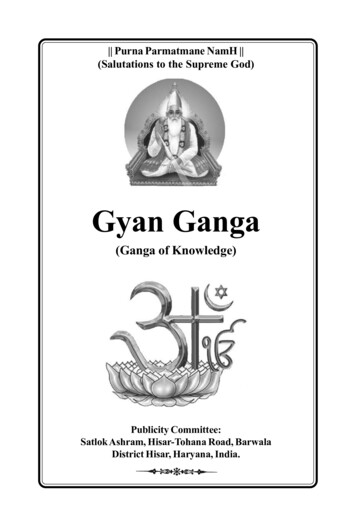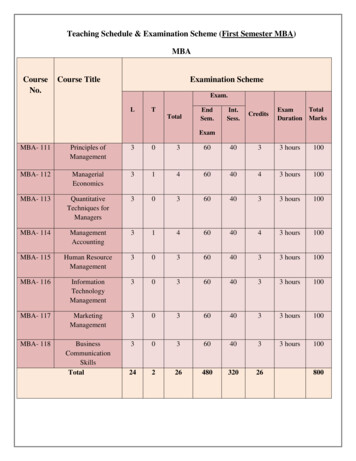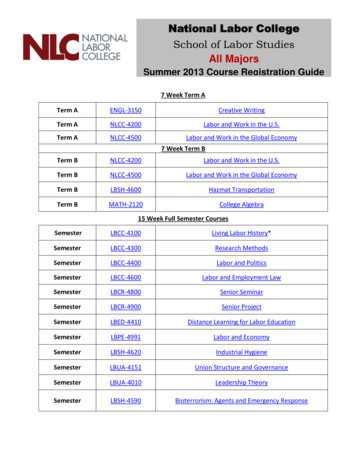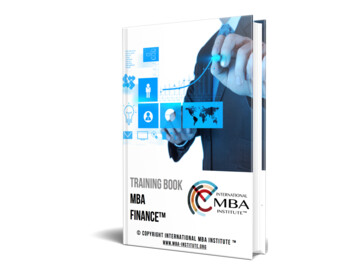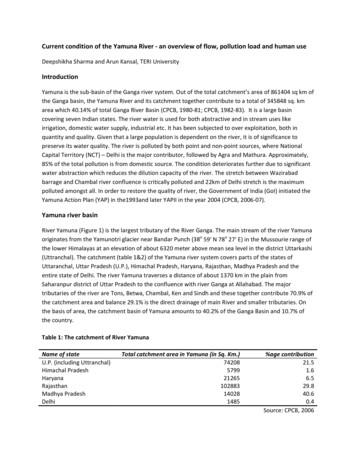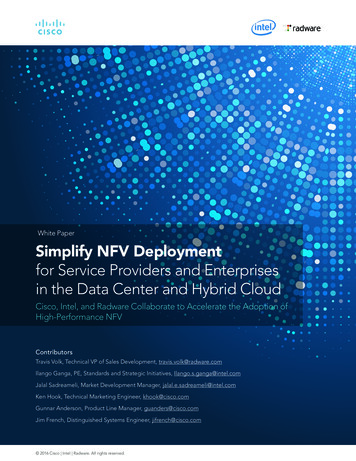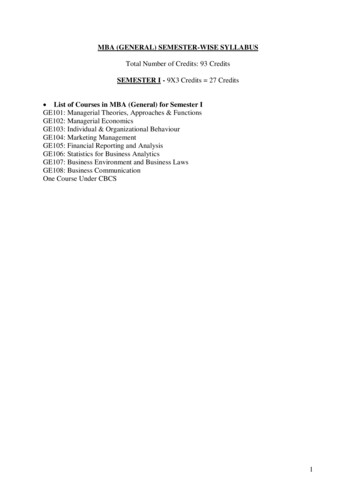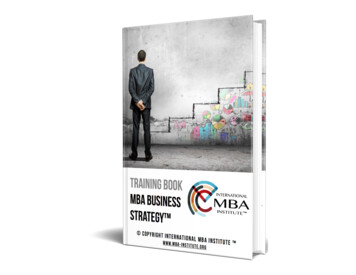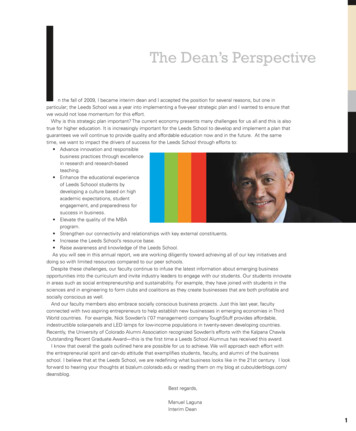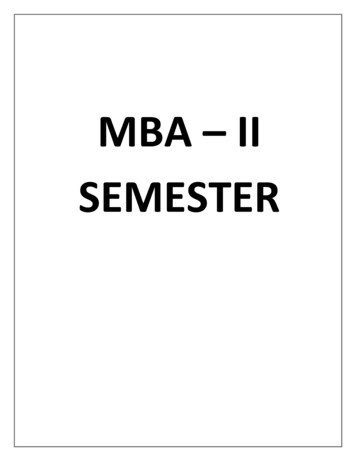
Transcription
MBA – IISEMESTER
SYLLABUS AND SCHEME OF EXAMINATION FOR MBA 2 YEARSFULL TIME PROGRAMMEScheme for SECOND SemesterThere will be 8-theory papers in this semester.The Internal marks will be calculated based on the following:Internal AssessmentTotal Marks 30Attendance10 MarksTest10 MarksSeminars/Cases analysis/Presentations:PapersPaperCode10 TER ENDEXAMINATIONMax.Min.MarksMarks7028MS-201Human Resource ManagementMS-202Corporate Finance30127028MS-203Marketing Management30127028MS-204Production And Operations Management30127028MS-205Business Research Methodology30127028MS-206Managerial Communication30127028MS-207Management Science30127028MS-208Retail Management30127028
MS-201 HUMAN RESOURCE MANAGEMENT[Max. Marks: 70][Min. Marks: 28]Course Objective – The objective of the course is to equip students with knowledge, skill and competencies tomanage people along with capital, material, information and knowledge asset in the organization. Theeffectiveness of human resource management in organization depends largely on individual perception,assumption and belief about people. The course will provide students logic and rationale to make fundamentalchoice about their own assumption and belief in dealing with people.UNIT I Introduction to Human Resource Management – Definition – Objectives and functions – Role andstructure of Human Resource Function in organizations, Present day Challenges of HRM, Strategic HRM,Global HRM, Role of HR Manager.Objectives and functions of Personnel management. Characteristics and qualities of Personnel Manager.Difference between Personnel Management, HRM and HRD.UNIT II Human Resource Policies: importance, essentials and formulation. HR procedures & practices. Human Resources Planning– Concept, Need, Objectives, Importance, Process and limiting factors. Manpower Estimation-Job analysis, Job Description, Job Specification.UNIT III The systematic approach to Recruitment & Selection: Recruitment & Selection Policy, Recruitment &Selection Procedures, Recruitment & Selection Methods and Evaluation process.Training and Development –Objectives, Needs, Process, challenges and Methods. Evaluation of TrainingPrograms. Introduction to Career and Succession Planning.UNIT IV Performance Appraisal: Definition, Purpose of appraisal, Procedures and Techniques including360 degree Performance Appraisal, Job Evaluation.Compensation Administration: Nature and Objectives of compensation, components of paystructure, Wage Policy in India – Minimum Wage, Fair Wage and Living Wage. Health & safetyIncentive Schemes: Meaning and Definition, Prerequisites, Types and Scope. Fringe Benefits.UNIT V Promotion, Transfer and Separation: Promotion – purpose, principles and types; Transfer – reason,principles and types; Separation – lay-off, resignation, dismissal, retrenchment, Voluntary RetirementScheme.Discipline and Grievance Procedures: Definition, Disciplinary Procedure, Grievance Handling Procedure,Conflict Management. Industrial Relations: Nature, importance and approaches of Industrial Relations
Concepts of JIT, TQM, Kaizen, Quality Circles.Internal AssessmentTotal Marks 30Attendance10 MarksTest10 MarksSeminars/Cases analysis/Presentations:10 MarksGuidelines for Case analysis / presentations: - Students should be given case studies as assignment and may beasked to present the same in the class for discussions, or seminars may be arranged on current issues related tothe subject and marks be given on the basis of students performance. (Cases or Seminars can be given onindividual basis or on group basis.)REFERENCE BOOKS Personnel ManagementPersonnel ManagementEconomics of Labour and IRManagement of Human ResourcesCases in Human Resources ManagementPersonnel ManagementHuman Relation WorkPersonnel Management & Human ResourcesHuman Resource Development & Mgt.A Handbook of Human Resource PracticeLondon, Kogan Page, 8th Edn., 2001.CB MamoriaRS DavarTN BhagoliwalPrasad & BanerjeeMN RudrabasavarajEB FlippoK. DavisV. Ratham, CS Venkata, V.K. ShrivastavaGhosh , BiswanathMichael Armstrong Personnel/Human Resource ManagementNew Delhi, Prentice Hall, 3rd Edn. 1988.David S. Decenzo and Stephen Robbins Human Resource Management9th Edn. South Western College Publishing, 1995.Robert L. Mathis and John H. Jackson
MS - 202 CORPORATE FINANCE[Max. Marks 70][Min. Marks: 28]Course Objective: - The objective of this course is to develop a conceptual framework of Finance function and toacquaint the participants with the tools, techniques and process of financial management for making financialdecisions.UNIT I Concept of Finance, scope and objectives of finance, Profit maximization vs. Wealth maximization,Indian Financial system. Financial Management function and Decision of Finance Manager in ModernAge. Financial Planning & forecasting.Accounting Standards. Introduction to International Accounting Standards. Role of Accounting Standardboard.UNIT II Fund Flow: Concept, Preparation of schedule of changes in working capital and the fund flow statement,Managerial uses and limitation of fund flow statement.Cash Flow Concept, Preparation of cash flow statement, managerial uses of cash flow statement.Concepts of Working Capital, Determinants of Working, Capital Operating and Cash Conversion Cycle,Permanent and Variable Working Capital. Symptoms of poor Working Capital management, WorkingCapital Management Strategies.UNIT III Long term financing sources and instruments – Shares and Debentures – Convertible securities& Term Loans – Foreign equity and debt securities. Valuation of shares, valuation of goodwill,methods of valuation of goodwill.Dividend policies - Factors affecting dividend decision - Dividend theories - Graham, Gordon,Walter and MM Theories - Plough back of earnings for expansion, diversification andmodernization.Investment Accounting: Concept & methods.UNIT IV Cost of capital: Equity, Debt, Retained earnings - Weighted Average Cost of Capital.
Capital structure theories –MM, Trading on Equity, Net income, Net operating income, Agency,Trade-off and Pecking Order Theories.Leverage Analysis- Types and significance.UNIT V Capital Budgeting: Nature, Features, Significance and Methods of Appraisal: Payback period,ARR, NPV and IRR. Capital Rationing. Concept of Risk and Return, Techniques of decision making under risk and uncertainty.Decision trees for sequential investment decisions.Internal AssessmentTotal Marks 30Attendance10 MarksTest10 MarksSeminars/Cases analysis/Presentations:10 MarksGuidelines for Case analysis / presentations:- Students should be given case studies as assignment and may beasked to present the same in the class for discussions, or seminars may be arranged on current issues related tothe subject and marks be given on the basis of students performance. (Cases or Seminars can be given onindividual basis or on group basis.)REFERENCE BOOKS Financial Management Theory and PracticeFundamentals of Financial ManagementFinancial Management and PolicyFinancial ManagementFinancial ManagementFinancial Decision ManagementFinancial ManagementFinancial ManagementCorporation FinanceMarketing ManagementBrighamHorne, Wachowiez Jr.Van-HorneS.C. KuchhalI.M. PandeyP. ChandraKhan and JainS.N. MaheshwariP.V. KulkarniMichael.R.Czinkota
MS-203 MARKETING MANAGEMENT[Max. Marks: 70][Min. Marks: 28]Course Objective - The course is designed to promote understanding of concepts, philosophies, processes andtechniques of managing marketing operation and to develop a feel of the market place.UNIT – I Concept, meaning, definition, evolution, nature, scope, importance and tools of marketing. Roleof Marketing in business organization.Consumer Buying Behavior: Concept, meaning, importance, determinants, process.Marketing Environment: External & Internal factor.UNIT – II Marketing Research: Meaning, Objectives, Process. Measuring Market Demand - DemandForecasting. Marketing Information SystemConcept of Marketing Segmentation: Selection of Target Market and Positioning.Marketing Strategies- Marketing strategies of Leaders, Challengers, Followers and Nichers.UNIT – III Concept of Marketing Mix, Four Ps of Marketing.Product: Concept of a product; Classification of products; Four Ps of Product, Major productdecisions.Product line and product mix; Branding; Packaging and labeling; Product life cycle – strategicimplications; New product development and consumer adoption process.UNIT – IV Concept and Meaning of Pricing- Significance of Pricing Decision, Pricing policies and strategies, Factorsaffecting price determination; Discounts and rebates.Place Decision- Nature, functions, and types of distribution channels; Distribution channelintermediaries; Channel management decisions and design, Marketing channel system - Functions andflows.
UNIT-V Promotion: Promotion mix, Sales promotion – tools and techniques, Selection of Promotionalchannel. Personal selling, Advertising& its effectiveness; Marketing Communication –Electronic Marketing, Digital Marketing, Green Marketing, Social Marketingand Event Marketing (Introduction and Concept). Rural Marketing – Meaning, Scope and Importance.Internal AssessmentTotal Marks 30Attendance10 MarksTest10 MarksSeminars/Cases analysis/Presentations:10 MarksGuidelines for Case analysis / presentations:- Students should be given case studies as assignment and may beasked to present the same in the class for discussions, or seminars may be arranged on current issues related tothe subject and marks be given on the basis of students performance. (Cases or Seminars can be given onindividual basis or on group basis.)REFERENCE BOOKS Marketing ManagementMarketing ManagementMarketing ManagementBasic MarketingMarketing ManagementMarketing ManagementMarketing applicationsMarketing ManagementMarketing ManagementKotlerKotler & ArmstrongStantonE Jerome McCarthyRamaswamyRajagopalRajagopalSarlekarR.S. Dawar
MS-204- PRODUCTION AND OPERATIONS MANAGEMENT[Max. Marks: 70][Min. Marks: 28]Course Objective - The objective of the subject is to explore the interlinking between operations managementand supply chain management. The course seeks to provide the key concepts and solution in the design,operation, control and management of supply chain as integrated systems.UNIT – I An overview, Definition, Systems Concept of production, Production Cycle, Classification of operations,Types of Production Systems – Flow, Job Shop, Batch Manufacturing and Project. Production Management Nature and Scope of Production and Operations Management. Types ofIndustries. Forecasting as a planning tool, Forecasting types and methods, Exponential smoothening, Measurementof errors, Monitoring and Controlling forecasting modelsUNIT – II Production Planning and Control Functions. Production and manufacturing organizations. Methods andprocedures in Production departments. Factory/plan location and plant layout. Production schedulingtechniques. Routing Decisions, Line of Balance, Scheduling types & principles, master productionschedule.Layout: Importance, Function, Objectives, Flow patterns, Layout types – Product, Process, GroupTechnology / Cellular Layout, Factors for Good Layout, Layout Design Procedure.UNIT – III Introduction to Study Methods – Work-study, Time – Study and Method-Study, Work Measurement,Evolution of Normal/Standard Time, Job Design and Rating.Materials Management Concept and Principles, Inventory Control and Inventory models. SelectiveInventory control, ABC, VED, FNS Analysis. Standardization, Simplification, Variety reduction andCodification.UNIT – IV
Quality Control and Value Engineering Total Quality Management, Quality circle and quality controlmethods ISO-9000. Value Engineering and Value analysis and cost reduction.Introduction to Supply Chain Management, The Basics of Supply Chain Management- Introduction,Definition of Supply Chain Management, Evolution of the Concept of Supply Chain Management, KeyDrivers of Supply Chain Management, Typology of Supply Chains, Cycle View of Supply Chain, Problemsin SCM. Logistics as part of SCM.UNIT–V Purchase and Stores Management-Principles of Purchasing and Purchase Management.Stores layout and stores location system. Stores handling equipments and storage methods. Stockverification. Waste and Scrap control and disposal surplus management.Internal AssessmentTotal Marks 30Attendance10 MarksTest10 MarksSeminars/Cases analysis/Presentations:10 MarksGuidelines for Case analysis / presentations:- Students should be given case studies as assignment and shouldbe asked to present the same in the class for discussions, or seminars may be arranged on current issues relatedto the subject and marks be given on the basis of students performance. (Cases or Seminars can be given onindividual basis or on group basis.)REFERENCE BOOKS Production ManagementModern Production ManagementOperations ManagementProduction and Operation ManagementConcepts Model and BehaviourMyersBuffa, E.S.Buffa, E.S.Adam, E.Sr. &Ebert, R Materials ManagementJapanese ManagementProduction ManagementProduction ManagementContemporary Operations ManagementProduction and Operation ManagementSupply Chain ManagementDutta, A.K.Srinivasan, A.V.HedgeGoel and GuptaCook and RusselNair, TMHB. S. Sahay
MS - 205 BUSINESS RESEARCH METHODOLOGY[Max. Marks: 70][Min. Marks: 28]Course Objective – The objective of this paper is to equip the student with the Philosophy of research alongwith the practical aspect of research. This paper will provide the insight about the various concepts of researchto better equip for dealing various business decision situations.UNIT I Introduction: Concept, Definition, Utility, Characteristics, Variable of Research and ItsApplication in Various Functions of Management. Concept of theory, empiricism, deductive andinductive theoryTypes of Research, Types of Business Problems Encountered by the Researcher, Problems andPrecautions to the Researchers.UNIT II Research Design : Concept and Importance in Research - Features of a good research design –Exploratory Research Design – concept, types and uses, Descriptive Research Designs - concept, typesand uses. Experimental Design: Causal relationships, Types of Variables.Process of Research: Steps Involved in Research Process. Research process-Conceptualization ofvariables and Measurement – Types and measurement of variables – Reliability and validity inmeasurement of variables- sources of error in measurement.UNIT III Hypothesis – Concept, meaning & importance. Qualities of a good Hypothesis, Types –NullHypothesis & Alternative Hypothesis. Hypothesis Selecting - Logic & Importance. Types of Data: Secondary and Primary - Definition, Advantages and disadvantages. Various Methods ofCollection of Data - Observation, Questionnaire, Personal Interviews, Telephonic Interview, Mail Survey,Email / Internet survey.Preparation of Questionnaire and Schedule- Types of Questions, Sequencing of Questions, CheckQuestions, Length of Questionnaire, Precautions in Preparation of Questionnaire and Collection of Data& editing.
UNIT IV: UNIT V Concept of Sample, Sample Size and Sampling Procedure, Various Types of Sampling Techniques Probability Sample & Non-Probability Sample. Determining size of the sample – Practical considerationsin sampling and sample size.Concept of Scale –Paired Comparison &Non paired comparison.Coding, Editing and Tabulation of Data, Various Kinds of Charts and Diagrams Used in DataAnalysis: Bar and Pie Diagrams and their Significance. Parametric tests: Testing for Means –One and Two Populations – One Way and Two Way ANOVA – Testing of Proportions: One andTwo Populations – Chi-square Test, Non-parametric tests: Sign test and Mann Whitney test. Introduction of Statistical Software’s- Like MS-Excel, SPSS, Stata, etc. Report Preparation: Types and Layout of Research Report, Precautions in Preparing theResearch Report. Bibliography and Annexure in the Report: Their Significance, DrawingConclusions, Suggestions and Recommendations to the Concerned Persons.Internal AssessmentAttendanceTotal Marks 3010 MarksTest10 MarksSeminars/Cases analysis/Presentations:10 MarksGuidelines for Case analysis / presentations:- Students should be given case studies as assignment and shouldbe asked to present the same in the class for discussions, or seminars may be arranged on current issues relatedto the subject and marks be given on the basis of students performance. (Cases or Seminars can be given onindividual basis or on group basis.)REFERENCE BOOKS Research Methodology andQuantitative TechniquesScientific Social Surveys and ResearchResearch Methodology in Social SciencesStatistical MethodsStatistics for Modern Business DecisionsStatistics for ManagementQuantitative TechniqueFundamental Concepts of Research MethodologyResearch Methods in Social Sciences.C.R. KothariP.V. YoungB.C. TendonS.P. GuptaLupine LawrenceLevin R.IU.K. ShrivastavaDr. V. K. MaheshwariSharma R.D.
MS – 206 MANAGERIAL COMMUNICATION[Max. Marks: 70][Min. Marks: 28]Course Objective - The primary objective of the course will be personality development of the students bymaking their effective communication. To acquaint the student with fundamentals of communication,help them honing oral, written and non-verbal communication skills in order to transform theircommunication abilities.UNIT I Introduction to Managerial Communication:- Meaning, Importance, objectives, principles ofCommunication, Elements of Communication Process, Essentials of effective communication. Forms&Channels of communication, 7C’s of Communication.Feedback – Need, importance and types. Factors o be considered while selecting Medium.Communication Models: Aristotle, Lasswell, Shannon - Weaver’s, Berlo’s SCMR.UNIT II Communication Barriers: Physical, Organizational, Socio-Psychological, Linguistic. Remedies to removebarrier. The Cross-Cultural Dimensions of Business Communication.Verbal Communication: Oral communication - meaning, principles, advantages and disadvantages ofeffective oral communication.Nonverbal Communication: Kinesics, Proxemics, Para Language.UNIT III Listening: process, need and types of listening.Speeches& Presentation: Stages and Principles of Effective Speech. How to make the speech effective.Speech of introduction - speech of thanks -occasional speech - theme speech. Presentations - elementsof presentation, designing a presentation, use of audio-visual aids.
Meetings: need, importance & planning of Meetings, drafting of notice, agenda, minutes & resolutionsof Meeting, writing memorandum, press release, press conference.UNIT IV Interview Techniques: Mastering the art of conducting and staging interviews, Interviewers preparation,candidate’s preparation, and types of interview - Selection interviews –grievance interviews - appraisalinterviews – exit interviews.Group Discussions: Do’s and Don’ts; Conference & Seminar, Roles & responsibility of participants andChairperson.Business and social etiquettes. E-mail: format, language and courtesy, common errors.UNIT V Business letters: style, layout and types of letters - Inquiries, Circulars, Quotations, Sales, Orders,Acknowledgments Executions, Complaints, Claims & adjustments, Banking correspondence, Agencycorrespondence, Bad news and persuading letters, Job application letters, Covering Letter, InterviewLetters.Reports: Definition & purpose, Types of Business Reports – Format Organization reports by individual,Report by committee.Internal AssessmentTotal Marks 30Attendance10 MarksTest10 MarksSeminars/Cases analysis/Presentations10 MarksGuidelines for Case analysis / presentations:- Students should be given case studies as assignment and maybeasked to present the same in the class for discussions, or seminars may be arranged on current issues related tothe subject and marks be given on the basis of students performance. (Cases or Seminars can be given onindividual basis or on group basis.)REFERENCE BOOKS Organizational CommunicationEffective Speaking in BusinessBusiness Communication, TheoryAnd Practice Information in EnterprisesJC Woffered, A. Gerloff & RC Cumins (McGraw Hills)Hston, Sandberg & Mills(Prentice Hall)RaymandlesikarG Danta
Business CommunicationBusiness CommunicationBusiness CommunicationBusiness Communication & CustomerRelationsRai & RaiKorlahalliHill &BoveeMadhukarMS-207 MANAGEMENT SCIENCE[Max. Marks: 70][Min. Marks: 28]Course Objectives – The course focuses on effective application of mathematical and research tools and techniquesfor managerial decision making.UNIT– I Operations Research Nature and significance of operation research, Scope and phases ofoperations research. Basic operations research models, Role of Computers in operationsresearch.Linear Programming (LP) Generalized Linear Programming Models. Solutions to LP Models byGraphical methods and Simplex methods. Big M method. Duality in LP Models.UNIT – II Special Types of Linear Programming. Transportation models and their solutions (Basic &Optimal).Assignment models and solutions (and its special cases).UNIT– III Special Operation Research Techniques Decision Theory and Decision tree.Theory of games, Replacement TheoryQueuing problems and models.
UNIT IV Job Sequencing Models and solutionsNetwork scheduling by PERT & CPM (Introduction and application)Network analysisTime estimationProbabilistic estimationUNIT V Inventory Control ModelDeterministic & probabilistic ModelsInternal AssessmentTotal Marks 30Attendance10 MarksTest10 MarksSeminars/Cases analysis/Presentations10 MarksGuidelines for Case analysis / presentations:- Students should be given case studies as assignment and may beasked to present the same in the class for discussions, or seminars may be arranged on current issues related tothe subject and marks be given on the basis of students performance. (Cases or Seminars can be given onindividual basis or on group basis.REFERENCE BOOKS Operations ResearchQuantitative TechniqueIntroduction to Management ScienceTahaUK Shrivastava.William D Stevenson(McGraw-Hill) Operations ResearchOperations ManagementQuantitative Approaches to ManagementPrinciples of Operation ResearchQuantitative TechniquesOperations ResearchQuantitative Analysis for Business DivisionNatrajan (Pearson)Russel (Pearson)Levin, Kirpatrick & RubinWagnerGK KothariKanti SwaroopBierman & Others
Fundamental of Operations ResearchDecision making through Operations ResearchQuantitative Techniques in ManagementOperations ResearchAck off & SaisiniThieranf & GrossVohra NDKalavathyMS – 208 RETAIL MANAGEMENT[ Max. Marks: 70][Min. Marks: 28]Course Objective- The objective of the paper is to acquaint the students with the fundamentals of retailbusiness. The paper provides exposure to multiple dimensions of the field and provides the insight of theemerging Retail World.UNIT I Concept, Functions, Channels of retailing, Retail formats and types, Modern retail formats, Etailing, Importance of retailing, Retail Marketing Mix, Retail Communication Mix, Challengesin retailing.Changing trends in retailing, Socio economic and technological Influences on retailmanagement, Retail Industry in India, Government initiatives towards retailing.UNIT II Retail consumer behavior, Factors influencing the Retail consumer, Customer decision makingprocess, Types of decision making, Market research for understanding retail consumer,Customer service and retention.Market Segmentation and its benefits, Kinds of markets, Definition of Retail strategy, Strategyfor effective market segmentation, Strategies for penetration of new markets, Growth strategies,Retail value chain.UNIT III Importance of Retail locations, Types of retail locations, Factors determining the locationdecision, Steps involved in choosing a retail locations, Measurement of success of location.
Meaning of Merchandising, Factors influencing Merchandising, Functions of MerchandisingManager, Merchandise planning, Merchandise buying, Analyzing- Merchandise performance,Visual Merchandising.UNIT IV Store administration, Premises management, Inventory Management, Store Management,Receipt Management.Retail Pricing, Factors influencing retail prices, Pricing strategies, Controlling costs.UNIT V Definition of Space Management, Store layout and Design, POP Displays, LogisticsManagement, Relationship Marketing Strategies, Credit Management, Crisis Management.Customer Relationship Management: Concept, history, purpose, phases, process, benefits anddisadvantages.Internal AssessmentTotal Marks 30 Attendance10 Marks Test10 Marks Seminars/Cases analysis/Presentations:10 MarksGuidelines for Case analysis / presentations:- Students should be given case studies as assignment and may beasked to present the same in the class for discussions, or seminars may be arranged on current issues related tothe subject and marks be given on the basis of students performance. (Cases or Seminars can be given onindividual basis or on group basis. )Retailing ManagementREFERENCE BOOKSLevy (McGraw-Hill)Retailing Management: Text and CasesPradhan and SwapnaRetail Management A Strategic ApproachBerman and EvansRetail Marketing ManagementGilbert(McGraw-Hill)
MBA - II SEMESTER . SYLLABUS AND SCHEME OF EXAMINATION FOR MBA 2 YEARS FULL TIME PROGRAMME Scheme for SECOND Semester There will be 8-theory papers in this semester. The Internal marks will be calculated based on the following: . MS-203 Marketing Management 30 12 70 28
